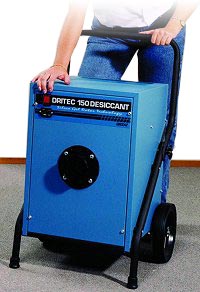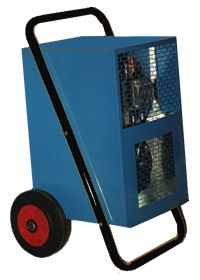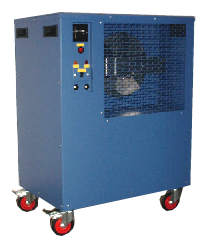How a dehumidifier works and other FAQs about dehumidifiers and humidifiers
How does a dehumidifier work?
There are four types of dehumidifier sold to the domestic market in
the UK - Compressor (the majority), desiccant, peltier and silica gel.
 A compressor
based dehumidifier draws the air in from the room over a filter and passes
it over some cold coils similar to the coils on a fridge. As
the coils are cold, water condenses and drips into a bucket.
The air is then reheated to room temperature and blown back out of
the dehumidifier. A compressor
based dehumidifier draws the air in from the room over a filter and passes
it over some cold coils similar to the coils on a fridge. As
the coils are cold, water condenses and drips into a bucket.
The air is then reheated to room temperature and blown back out of
the dehumidifier.
A desiccant dehumidifier has no coils and uses a wheel filled
with a moisture absorbing desiccant material to extract the water from the
air. The air is then reheated to about 10°C above room temperature and is
then blown back into the room.
A peltier dehumidifier basically uses a cold metal surface to
condensate the air on. These should not be used below 15°C and will not
control much more than a large wardrobe.
A silica gel based dehumidifier normally comes in a tub or a
rechargeable cassette and should not be used to control more than a box/draw or
wardrobe.
Why does water appear on my windows/cupboards/walls?
It is a basic law of physics that if the surface is cold enough and if
there is enough water vapour in the air then it will condense.
This means in the case of windows whether they are double-glazed
or not that if the windows are cold enough and there is enough moisture
in the air then condensation will occur.
Where does this water come from?
We all produce water by drying clothes indoors, the boiling of vegetables,
showering, rain, calor gas heating and making cups of tea all produces
moisture. It is just an on-going process that never
stops.
 Can
I just get rid of it by opening my windows? Can
I just get rid of it by opening my windows?
This is fine on a nice summers day but in winter opening your windows
will just result in you losing the heat from your central heating and
creating draughts. This is a waste of money and if
it is raining will just let more moisture in. You might
as well just throw fivers out of the window.
Will a dehumidifier do the whole house?
A dehumidifier creates a volume of dry air in as large a space as its
fan can effect. After that it will be helped by the
fact that damp air will always migrate to dry places. As
long as you leave all of the internal doors open a correctly sized dehumidifier
will prevent condensation and mould from appearing around the whole house.
What about the black spots of mould on my window and bathroom
sealant?
Mould occurs around 68% humidity, condensation occurs at 100%.
As you can see from this you can have mould but still have clear
windows. A dehumidifier will prevent the mould from
getting any worse and once you have cleaned the mould away, it will stop
it from coming back.
Do I put it in the worst room?
You can if you like put it in the main problem area to start with and
then move it somewhere more convenient when you feel that the problem
is under control. If it is just condensation on the
windows that you are worried about a dehumidifier in a central position,
at for example the bottom of the stairs, will cure the problem in the
whole house.
Are they expensive to run?
A compressor based dehumidifier costs about 2-3p an hour to run.
You should take into consideration the fact that the dehumidifier
will not run all the time, as it will be controlled via its humidistat.
Secondly it is very expensive to heat a damp house and you will
see a reduction in your central heating bill when you start to use your
dehumidifier.
What is the humidistat?
Just as you have a thermostat that you set on your central heating you
have a humidistat on your dehumidifier. This will allow
the dehumidifier to turn off and on as required without you having to
worry about it.
Should I turn the dehumidifier on for just a few hours a day?
No just let the dehumidifier decide when to come on using its humidistat.
Will they help with allergies?
 A
dehumidifier will reduce the relative humidity in the house, which will
prevent dust mites and other pests from breeding. In
this way a dehumidifier can help with allergies. A dehumidifier
that can be found in your local high street store is designed for use
in your home, which is nice and warm. In a garage,
store, workshop, boat, caravan, holiday home or a conservatory the temperature
will drop a lot lower. Since a compressor based dehumidifier
works by reducing the temperature internally it can easily reduce down
to freezing even if the ambient temperature is 10°C. What
you do not want is for your dehumidifier to form a block of ice or for
you to find a puddle on the floor. A
dehumidifier will reduce the relative humidity in the house, which will
prevent dust mites and other pests from breeding. In
this way a dehumidifier can help with allergies. A dehumidifier
that can be found in your local high street store is designed for use
in your home, which is nice and warm. In a garage,
store, workshop, boat, caravan, holiday home or a conservatory the temperature
will drop a lot lower. Since a compressor based dehumidifier
works by reducing the temperature internally it can easily reduce down
to freezing even if the ambient temperature is 10°C. What
you do not want is for your dehumidifier to form a block of ice or for
you to find a puddle on the floor.
What happens when the temperature in the room drops down towards
freezing?
Most dehumidifiers designed for use in the home will just stop working
and turn themselves off. Others will try to work and
might well suffer from a build up of ice. Those with
a defrost system are likely to only extract a tiny amount of water.
What is the correct type of dehumidifier to use in these applications?
You need a machine with a function called hot gas defrost or a desiccant
based machine. If the dehumidifier does not have either
of these features then do not buy it.
How does Hot Gas Defrost work?
Hot gas defrost works by reversing the coils and using the heat from
the hot side of the coils to melt the ice to water. When
this is done the heat is returned to the front of the machine to warm
the air before it is blown back out.
So what temperature will a hot gas defrost system or a desiccant
dehumidifier work down to?
Freezing.
|
